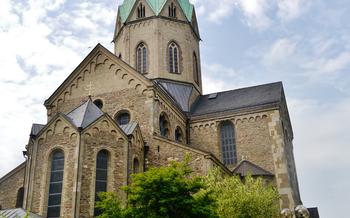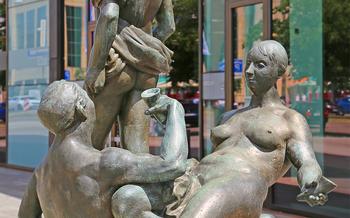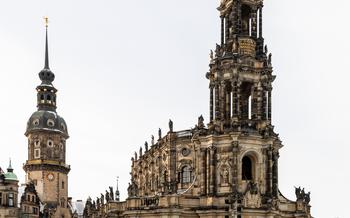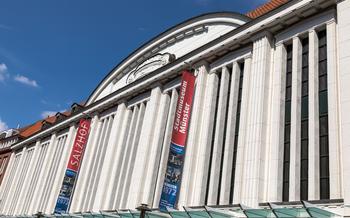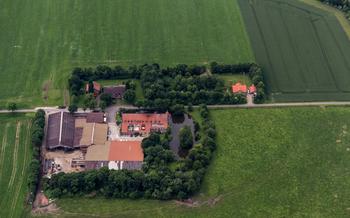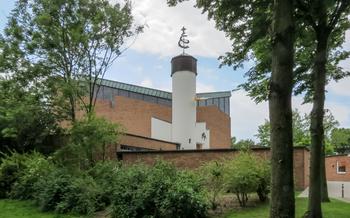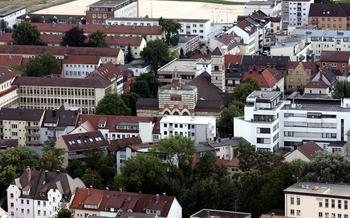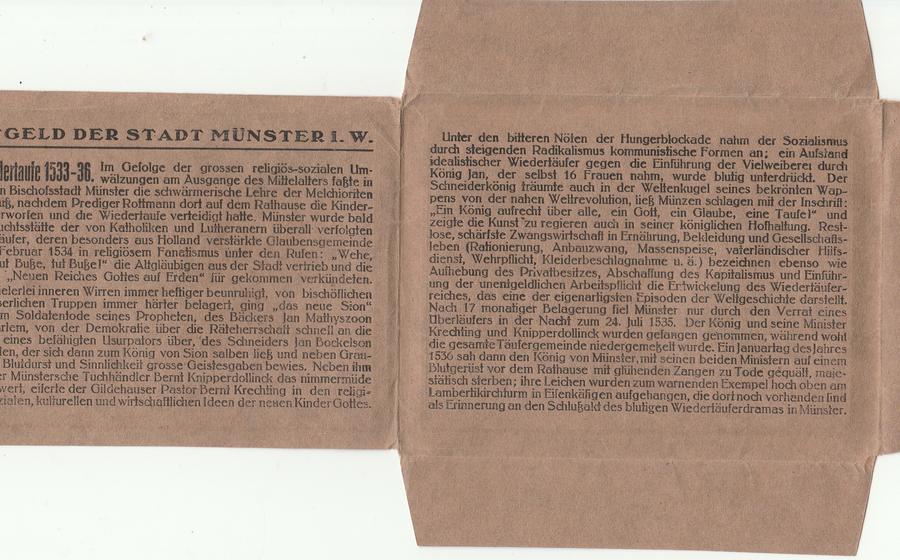
Ludgerusbrunnen
- A City of History and Culture
- A Tribute to Saint Ludger
- A Work of Art
- The Four Lions
- The Central Figure
- The Supporting Cast
- The Water Feature
- A Place of Contemplation
- A Symbol of Münster
- A Must-See for Visitors
- Insider Tip
A City of History and Culture
Münster, a city steeped in history and brimming with cultural allure, is a captivating destination that draws visitors from far and wide. Its rich tapestry of architectural heritage, vibrant events, and captivating festivals has earned it a reputation as a cultural hotspot in Germany.
Strolling through the cobblestone streets of Münster's historic center, one is transported back in time, surrounded by magnificent buildings that whisper tales of the city's glorious past.
A Tribute to Saint Ludger
Saint Ludger, also known as Liudger, was a Benedictine monk and missionary who played a pivotal role in the Christianization of Northern Europe during the 8th century. Born into a noble family in Friesland, Ludger was drawn to a life of religious devotion from a young age. He received his education at the renowned monastery of Utrecht under the tutelage of Saint Gregory, the first bishop of Utrecht.
Inspired by the teachings of Saint Boniface, the "Apostle of Germany," Ludger embarked on a mission to spread Christianity among the pagan tribes of Saxony. With unwavering determination and a deep sense of faith, he traveled extensively throughout the region, preaching the Gospel and establishing churches. His efforts were met with both resistance and success, as he faced challenges from pagan beliefs and customs.
Ludger's dedication and unwavering faith eventually bore fruit. He founded several monasteries, including the Werden Abbey in present-day Essen, which became a center of learning and religious life. His influence extended beyond Saxony, reaching as far as Westphalia and Frisia. Ludger's tireless efforts earned him the title of "Apostle of the Saxons," and he is revered as the patron saint of Münster to this day.
A Work of Art
The Ludgerusbrunnen is not merely a fountain but a true work of art, showcasing the exceptional skill and artistry of its creators. The fountain's intricate sculptural details and historical representations captivate visitors and reveal the depth of craftsmanship involved in its construction.
The central figure of Saint Ludger, surrounded by four majestic lions, dominates the fountain's composition. The depiction of Saint Ludger is particularly striking, with his serene expression and intricate details that bring the figure to life. The four lions, symbols of strength and courage, are depicted in dynamic poses, adding a sense of movement and energy to the fountain.
The fountain also features several smaller figures and reliefs that add to its narrative and symbolic value. These figures, representing historical and religious figures, contribute to the fountain's rich iconography and provide a glimpse into the history and culture of Münster. The overall effect is a harmonious blend of artistic and historical elements, creating a visually captivating masterpiece.
The Four Lions
The four majestic lions that flank the fountain serve as potent symbols of strength and unwavering courage. These noble beasts, with their fierce expressions and powerful musculatures, embody the indomitable spirit of Münster and its people. Position at the fountain's base, the lions stand as guardian figures, eternally vigilant, protecting the city from harm and adversity. Their presence evokes a sense of security and reassurance, reminding the people of Münster that they are not alone in facing life's challenges.
The Central Figure
The central figure of the Ludgerusbrunnen is, unsurprisingly, Saint Ludger himself. Standing tall and proud, his statue is a testament to his enduring legacy in Münster. The artist has captured Ludger's likeness with meticulous detail, from his flowing robes to his serene expression.
Ludger's right hand is raised in a gesture of blessing, while his left hand holds a crosier, a symbol of his authority as a bishop. His gaze is directed slightly upwards, as if he is looking towards heaven or perhaps contemplating the future of his beloved city.
The statue's craftsmanship is exquisite, with intricate carvings that highlight Ludger's facial features, his clothing, and the folds of his robes. The artist has also paid close attention to the details of the crosier, which is adorned with delicate ornamentation.
Overall, the central figure of Saint Ludger in the Ludgerusbrunnen is a masterpiece of sculpture that captures the essence of this revered figure and his profound impact on the city of Münster.
The Supporting Cast
The Ludgerusbrunnen is not just about Saint Ludger. It is surrounded by a host of other figures, each with its own story to tell. There's the archangel Michael, defeating the dragon with his sword. There's Saint Paul, holding a book and a sword, representing his role as an apostle. And there's Saint Peter, holding the keys to the Kingdom of Heaven.
These additional figures are not just decorative elements. They are an integral part of the fountain's narrative, providing historical and religious context. They help to tell the story of Saint Ludger and his legacy, and they remind us of the rich history of Christianity in Münster.
The supporting cast of the Ludgerusbrunnen is a testament to the artistic craftsmanship and historical accuracy of the fountain. Each figure is carefully rendered, with attention to detail and symbolism. Together, they create a harmonious ensemble that brings the fountain to life.
The Water Feature
The Ludgerusbrunnen boasts a captivating water feature that further enhances its allure and symbolism. The fountain's refreshing waters, sourced from a nearby spring, cascade gently into the basin below, creating a soothing and tranquil atmosphere. The movement of the water adds a dynamic element to the fountain, drawing the eye and inviting contemplation.
Water, with its life-giving and cleansing properties, holds profound symbolic meaning in many cultures. In Christianity, water represents baptism, purification, and regeneration. The flowing water of the Ludgerusbrunnen symbolizes the spiritual renewal and transformation that can be found through the teachings of Saint Ludger.
Beyond its symbolic significance, the water feature also provides a refreshing and calming effect on visitors to the fountain. The gentle sound of the water cascading into the basin creates a soothing ambiance, inviting passersby to pause and take a moment to appreciate the beauty and tranquility of their surroundings.
A Place of Contemplation
The Ludgerusbrunnen exudes a serene and contemplative atmosphere, inviting visitors to pause and reflect amidst the vibrant city center. The gentle flow of water and the intricate details of the fountain's sculptures create a tranquil oasis, perfect for seeking solace and inner peace. Whether you're a local resident seeking a moment of respite or a traveler seeking a deeper connection with Münster's history and culture, the Ludgerusbrunnen offers a sanctuary for contemplation and reflection.
Immerse yourself in the fountain's rich symbolism, tracing the life and legacy of Saint Ludger and the founding of Münster. Let the water's gentle murmur wash away your worries as you contemplate the intricate details of the sculptures, each one telling a story from the city's past. Find a quiet spot to sit and soak in the fountain's serene ambiance, allowing the historical and religious significance of this iconic landmark to wash over you.
A Symbol of Münster
The Ludgerusbrunnen is not just a fountain; it is a symbol of Münster, a beloved landmark that holds a special place in the hearts of the city's residents. It is a source of pride and identity for the city, representing its rich history, cultural heritage, and deep-rooted religious traditions. The fountain serves as a reminder of the city's patron saint and the important role he played in shaping Münster's destiny.
The Ludgerusbrunnen is a living piece of history that reflects Münster's past and its ongoing evolution. It stands as a testament to the city's resilience and its ability to overcome challenges and adversity. The fountain has become an integral part of the city's landscape, a familiar and comforting sight that is cherished by both locals and visitors alike.
A Must-See for Visitors
The Ludgerusbrunnen is undoubtedly a must-see attraction for any visitor to Münster. It stands as a testament to the city's rich history, cultural heritage, and deep-rooted faith. The fountain's intricate details, historical significance, and artistic value make it a captivating sight that leaves a lasting impression. Whether you're a history buff, an art enthusiast, or simply someone who appreciates beautiful things, the Ludgerusbrunnen is a must-see attraction that should not be missed. Take your time to admire its intricate carvings, learn about the life and legacy of Saint Ludger, and soak in the serene atmosphere that surrounds this iconic landmark. The Ludgerusbrunnen is a true masterpiece that embodies the spirit of Münster and is sure to leave you with a lasting memory of your visit to this historic city.
Insider Tip
-
Timing your visit: The Ludgerusbrunnen is a popular spot and it can get crowded during peak tourist season. To avoid the crowds and enjoy the fountain's serene atmosphere, visit early in the morning or late in the evening.
-
Photography Tips: The best photos of the Ludgerusbrunnen are taken from a low angle to capture the full grandeur of the fountain. Be sure to include the surrounding buildings in your shot to provide context and a sense of place.
-
Hidden Detail: Look closely at the base of the fountain and you'll see a series of small carvings depicting scenes from the life of Saint Ludger. These intricate details add depth to the fountain and provide a glimpse into the history of Münster.
